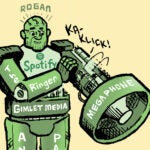 “Data Driven Thinking” is written by members of the media community and contains fresh ideas on the digital revolution in media.
“Data Driven Thinking” is written by members of the media community and contains fresh ideas on the digital revolution in media.
Ramsey McGrory was CEO of AddThis and previously ran Right Media for Yahoo!
I read a lot: business plans and other fiction, nonfiction and — more recently — William Safire’s “On Language” columns. I’ve always been a student of language and these pieces are just good content. They got me thinking about words in our industry that are used often and are loaded, divisive or just not commonly understood. “Premium” has to be right up near the top of the list.
Sellers generally use “premium” to make an argument for higher rates. More recently, ad-tech companies have used “premium” with “programmatic” to argue that programmatic is more than the assumed unsavory inventory. Regardless of where it’s used, its definition is not a matter of common agreement between buyers and sellers. If there is one thing that’s certain in the world, it’s that people with religious points of view are certain of them.
Rather than take a side, it might be more productive to identify the variables that we can all agree may merit a premium or charge above the “normal” rate, as defined by open-market RTB inventory-clearing prices. With common currencies, the conversations are more negotiations than religious arguments.
X + Y = Premium
There are only two good outcomes for a buyer when a publisher displays an ad: One is the audience is very appropriate, and the other is the ad got their attention. Quality of audience and quality of attention are the elements that can define “premium.” Let’s break down the variables. (For the purposes of this conversation, I won’t focus on buy side or third-party data)
- Targeting. This is defining an audience more discretely. Geographic, context, behavioral, registration, composite measures. Also the ad unit and any data potentially used in the actual ad to define the message.
- Access/Transparency. Is the publisher presenting the ad spot transparently (URL level), aggregating at a domain level or is it obfuscated at a category level (e.g., sports)? Also, is the publisher providing access to some potential buyers and not others?
- Guarantee of delivery. (Or the derivative: guarantee it was viewed or engaged with.) Is there so much supply that a guarantee has to be provided? Is the publisher providing a guarantee that the ad will be delivered? An important recent derivative is whether the ad was actually viewed.
- Quality of engagement. Beyond whether it was viewed, does the publisher’s site provide engagement which is deeper and more valuable?
- Integration (beyond nonstandard). Is this an animated gif or Flash ad, or is it more interruptive, intrusive, broken out of the ad placement or somehow integrated into the page?
The above are straightforward and I haven’t heard other variables that can’t be dropped into one of these buckets. Most sophisticated publishers have inventory-management systems (from .xls to fully blown software) to calculate the premium for each of these factors. A lot of conversations seem to hang on the last one.
Publisher Brand Association
When a publisher says, “Our brand or content is a premium,” it is making two arguments. First, the publisher (e.g., WSJ.com) is saying it commands higher rates partly because its measures indicate better ad performance. This is captured in No. 1 above. Second, it is saying that consumers are more receptive to a particular message when the ad is placed on their site, or that the halo of their context reflects well on the brand. Both claims can be validated with good measurement.
When you break down “premium” this way, I think it’s infinitely easier to talk about the premiumness of inventory. Do you agree that these are the factors that define “premium?” This may seem basic and it is, but “premium,” like “insight,” is so vague that it’s often not helpful in conversations or negotiations. Whenever you hear either word, spend time to understand what your partner means.
While I’m channeling William Safire, I think the phrase “programmatic premium” is funny. How is it different from an insertion order?
Follow Ramsey McGrory (@nycmcg) and AdExchanger (@adexchanger) on Twitter.












